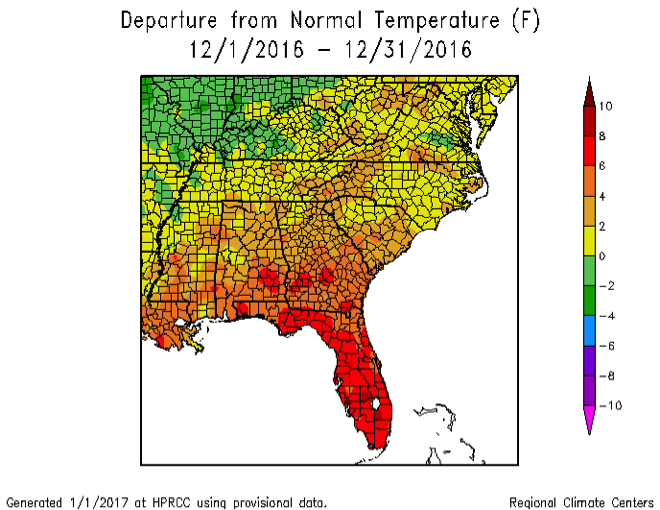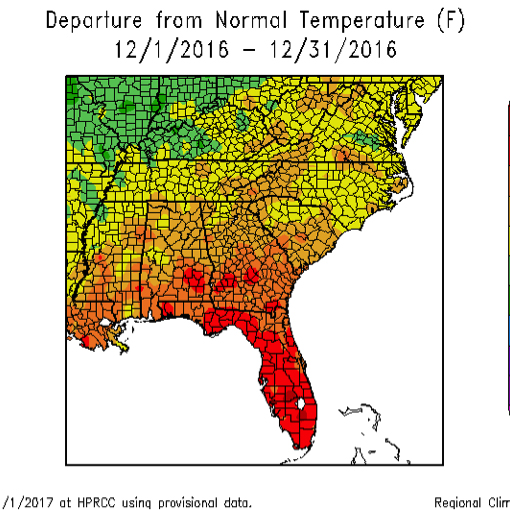While the rain in December 2016 eliminated abnormally dry conditions along the Georgia coast and reduced drought conditions in southern Atlanta and south Georgia, only limited relief was seen in north Georgia.
The outlook for January shows an increased chance of above-normal temperatures and wetter-than-normal conditions. The warm conditions are likely to continue into spring, but drier conditions may return as the weak La Nina ebbs away.
December’s heat and varying rainfall had limited impacts on agriculture in Georgia. December was much warmer than normal across the state, with some areas over six degrees above normal. Rainfall was highly variable this month. The northern half of the state remained quite dry, while much of the southern half was inundated with heavy rain, particularly from Dec. 4 to Dec. 6.
- In Atlanta, the monthly average temperature was 48.9 degrees Fahrenheit, 3.6 degrees above normal.
- In Athens, Georgia, the monthly average temperature was 47.1 F, 1.7 degrees above normal.
- In Columbus, Georgia, the monthly average temperature was 52.5 F, 3.4 degrees above normal.
- In Macon, Georgia, the monthly average temperature was 52.2 F, 4.2 degrees above normal.
- In Savannah, Georgia, the monthly average temperature was 56.4 F, 4.7 degrees above normal.
- In Brunswick, Georgia, the monthly average temperature was 59.1 F, 5 degrees above normal.
- In Alma, Georgia, the monthly average temperature was 56.6 F, 4 degrees above normal.
- In Augusta, Georgia, the monthly average temperature was 52.1 F, 4.9 degrees above normal.
- In Albany, Georgia, the monthly average temperature was 57.3 F, 6.3 degrees above normal.
- In Rome, Georgia, the monthly average temperature was 45.4 F, 2.8 degrees above normal.
- In Valdosta, Georgia, the monthly average temperature was 57.7 F, 4.6 degrees above normal.
Macon and Augusta set new record highs of 81 F and 84 F, respectively, on Dec. 18, surpassing the old records of 79 F and 82 F set in 2008. Brunswick tied several record highs on Dec. 18, 24 and 29, and broke a record high on Dec. 6 at 81 F, which surpassed the old record of 79 F set in 1972.
The highest monthly total precipitation from National Weather Service reporting stations was 10.68 inches in Albany – 6.93 inches above normal – and the lowest was in Valdosta with 2.15 inches – 1.02 inches below normal.
- Atlanta received 3.00 inches, 0.9 of an inch below normal.
- Athens received 2.42 inches, 1.31 inches below normal.
- Columbus received 4.37 inches, 0.1 of an inch above normal.
- Macon received 5.95 inches, 1.91 inches below normal.
- Augusta received 4.41 inches, 1.02 inches above normal.
- Savannah received 4.29 inches, 1.34 inches above normal.
- Alma received 4.72 inches, 1.43 inches above normal.
- Brunswick received 3.02 inches, 0.38 of an inch above normal.
- Rome received 3.41 inches, 0.97 of an inch below normal.
Several daily rainfall records were set on Dec. 5 across southern Georgia. Savannah received 1.36 inches, breaking the old record of 1.17 inches set in 1994. Alma received 2.16 inches, surpassing the old record of 1.16 inches set in 1954. Although the National Weather Service does not publish daily rainfall records for Albany, the 5.47 inches that city received on the same day was undoubtedly a daily record as well.
The highest one-day rainfall recorded by a Community Collaborative Rain, Hail and Snow Network observer was 6.9 inches reported on the morning of Dec. 6 northeast of Baconton, Georgia, in Mitchell County in the southwestern part of the state, followed by 6.48 inches northeast of Camilla, Georgia, in the same county. An observer near Tifton, Georgia, in Tift County received 6.26 inches on the same day. The highest monthly total – 12.42 inches – was recorded west of Albany in Dougherty County, followed by 11.15 inches at the Camilla station and 10.76 inches near Sylvester, Georgia, in Worth County.
There were isolated reports of wind damage on Dec. 13, 28 and 29. An EF1 tornado damaged between 25 and 30 homes near Jefferson, Georgia, in Jackson County early on Dec. 29. No injuries were reported.
For more information, visit GaClimate.org or the “Climate and Agriculture in the South East” blog at blog.extension.uga.edu/climate/. Please email pknox@uga.edu with your weather and climate impacts on agriculture to share on the blog.








